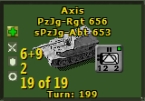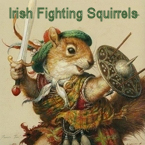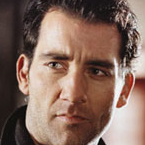RFalvo69
Posts: 1380
Joined: 7/11/2013
From: Lamezia Terme (Italy)
Status: offline

|
I'll give a practical example of the TOAW problem which, I believe, is in topic - because it is about how NOT to use modern computer power. Well, at least IMHO.
Just look at the scenario "Sicily to Brenner Pass 43-45" in TOAW IV. It covers the Western Front from Husky to the German surrender in one day turns (remember, Erik, what I told you a few posts ago? give to the players WitE3 with one day turns and they will play it)
I launched it, and it is what I feared: simply because it was possible to do it it was done. Was it also sane? WitE uses one-week turns and no scenario in Grigsby's game is as big as this one. And in Sicily to Brenner you must hope, even with TOAW IV's method of patching the turn-burn, that nothing dire happens in a single fight around, let's say, Florence, or the whole of the Western Front takes a hit.
("Down with WitE 1&2 and WitW!", BTW: obviously they "don't understand the awesomeness of this TOAW feature, possibly misunderstanding it and unfairly snubbing it.
Right?  ) )
What's happening here?
Let's step back to 1998. TOAW comes out, with a very, very flexible editor but also some words of warning by Norm Koger: the system was built for "units with reasonable OOBs" but also (and this somehow fell through the net) "for reasonable pairing of time and space by the scenario designers". Pairing of the extremes, in short, was not suggested and could lead to "serious distortions in the realism of the scenario".
TOAW was designed for the "OPART100" version of the .exe. Norm, back then, provided a OPART300 experimental .exe, the key word being "experimental". What, I believe, some people missed (and are still missing) was how TOAW was built for the aforementioned reasonable pairings of turn length/hex size/unit size - running under OPART100.
The "turn burn" feature of TOAW worked as long as Norm's warning were followed. It worked long as the scenario allowed for the player to always have full comprehension of the situation. It was a workaround designed to simulate a realistic tempo on the battlefield in absence of true continuous time (for some reason I always associated it with a totally different workaround: the "residual fire" rule in ASL). If you wanted to see how the attack in the north went before committing the rest of your troops, these troops had less "time" to move and act.
When this was achieved, the emergent result was that the average wargamer's mind was able to keep what happened on the battlefield under control. This is why the "turn burn" mechanic worked: because the whole of the battlefield was easily in the player's mind, with, if needed, quick checks in the various area. Even "monster" scenarios like (warning: fan service  ) Bob Cross' "Campaign for North Africa" were playable - because it was easy to keep the situation of your troops under control (I have this clear memory of playing CFNA 40 around 2000, while I was renovating what had been my father's restaurant. I played 2-3 turns every evening and it was very relaxing). ) Bob Cross' "Campaign for North Africa" were playable - because it was easy to keep the situation of your troops under control (I have this clear memory of playing CFNA 40 around 2000, while I was renovating what had been my father's restaurant. I played 2-3 turns every evening and it was very relaxing).
All the above leads to some questions:
- If this feature created by Norm is the cats ass, why no one else ever used it in its designs? Why WitE 1&2 and WitW, the current pinnacle of wargaming ever (or so I'm told), still use this prehistoric idea of moving and attacking with the units one at the time (not to mention every other hex'n'counter game sold here and elsewhere)?
- Why, in TOAW IV, we are still trying to tweak it so not to have a stubborn English company near Pisa delaying, you know, OVERLORD?
- And why we have scenarios like "Sicily to Brenner Pass" or, God forbids, "Directive 21"? These are examples of what "Jurassic Park" tried to teach us: "Just because you can do it this doesn't mean that you must do it." They symbolise what Norm Koger, cosplaying as Michael Crichton, tried to warn us about: "TOAW works as long as turn length/hex size/unit size are reasonable" - in an engine originally born for OPART100. And "reasonable" =/= "doable".
Of course there are people who play these scenarios. After all I once met a guy that played 3D Chess on multiple chessboards. The TOAW IV AARs subforum is full of people who tackle, let's say, "Nach Frankreich 1940t". No doubt about that. Pity that an operational study with 6 hours turns/2.5km hex/company-battalion of the crucial events between Dinant and Sedan on May 12nd-14th 1940 - something TOAW was born to portray - screams for its absence. OTOH we have a couple of hundred of version of "Barbarossa" and "East Front 1941-45" - because you can do it.
Fact is, I would gladly tackle "Sicily to Brenner" in a "WitW way": i.e. without the turn-burn rule at all and by just moving and attacking with the units (posture, events and the rest included). Basically, being able to conduct a desperate retreat as the Germans without having to worry that a platoon of Panzergrenadiers eating at "La Buca di Sant'Antonio" in Lucca (very good place BTW: if you visit Lucca, go there) is paralysing my I SS Panzer Korp relief attack against Metz.
But you can't have the option (about which I dream since TOAW I) of moving and attacking "WitE/W way"). Do you know why? Because the turn-burn feature is holy  . If you don't like it you "don't understand it and are inappropriately criticising it" (a very unfortunate judgement that, if true, would reflect very badly against a lot of contemporary designers from across many publishers). . If you don't like it you "don't understand it and are inappropriately criticising it" (a very unfortunate judgement that, if true, would reflect very badly against a lot of contemporary designers from across many publishers).
Notice how the above judgement is not mandatory. First, what is asked for is simply an option, not a definitive change of the game. Second, by simply stopping and gathering their own thoughts, people could instead point out a real problem: how the balance of the scenarios could be thrown out of whack. True, but there are two answer to this. First: on the other side a squad from the 101st Airborne Division found a good bistrot where eat in Paris (I suggest "Le Corail" in Rue Lafayette) was, once upon a time, enough to stop Market Garden - now, no more; so both sides would be gratified by a more relaxed approach.
But, second, we are already having a lot of scenarios potentially out of whack - because they were designed for earlier versions of the game. I guess that Bob will be able to answer to this question better than me, but, how many scenarios in TOAW IV were either rebuilt/created from scratch for the new new iteration of the game vs. the piles of old scenarios that were just thrown into the mix without being specifically tweaked for the new iteration?
I see that I wrote a long post but the TL;DR is brief: I think that the turn-burn feature of TOAW works very well for the kind of use Norm Koger originally envisioned for his engine. Nothing however, in design, is absolute (this small gem actually comes from my eldest daughter). The turn-burn feature is not holy at all, and loses its positive design effect once the TOAW engine is used beyond the originally envisioned confines.
But let's not throw away the baby with the water. TOAW allows a lot of things - from the scenario creation itself to the event engine, and more, and these things works.
Again: the turn-burn feature is not holy. There are reasons why, after almost 25 years, other designers never adopted it in their games - and we are still tweaking and patching it so that it can fit in holes that were never meant for it. I would just like for people to stop and think why.
_____________________________
"Yes darling, I served in the Navy for eight years. I was a cook..."
"Oh dad... so you were a God-damned cook?"
(My 10 years old daughter after watching "The Hunt for Red October")
|
 Printable Version
Printable Version


















 ) Bob Cross' "Campaign for North Africa" were playable - because it was easy to keep the situation of your troops under control (I have this clear memory of playing CFNA 40 around 2000, while I was renovating what had been my father's restaurant. I played 2-3 turns every evening and it was very relaxing).
) Bob Cross' "Campaign for North Africa" were playable - because it was easy to keep the situation of your troops under control (I have this clear memory of playing CFNA 40 around 2000, while I was renovating what had been my father's restaurant. I played 2-3 turns every evening and it was very relaxing). 
 New Messages
New Messages No New Messages
No New Messages Hot Topic w/ New Messages
Hot Topic w/ New Messages Hot Topic w/o New Messages
Hot Topic w/o New Messages Locked w/ New Messages
Locked w/ New Messages Locked w/o New Messages
Locked w/o New Messages Post New Thread
Post New Thread